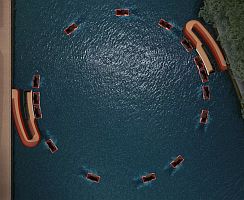 In March of 2018, we posted about a pilot project led by the Massachusetts Institute of Technology (MIT) and the Amsterdam Institute for Advanced Metropolitan Solutions (AMS) to develop autonomous barges, referred to as “roboats”, to carry cargo and passengers on Amsterdam’s 100 km of canals. Now MIT and AMS have developed a new application for the roboats. In a project known as roundAround, a fleet of autonomous boats would run between the island of Kattenburg to the east of Amsterdam and the city center.
In March of 2018, we posted about a pilot project led by the Massachusetts Institute of Technology (MIT) and the Amsterdam Institute for Advanced Metropolitan Solutions (AMS) to develop autonomous barges, referred to as “roboats”, to carry cargo and passengers on Amsterdam’s 100 km of canals. Now MIT and AMS have developed a new application for the roboats. In a project known as roundAround, a fleet of autonomous boats would run between the island of Kattenburg to the east of Amsterdam and the city center.
The boats would move in a continuous circle across the canal, picking up and dropping off passengers via a charging station. Currently, walkers have to make a 1km detour to make the crossing.
As reported by Global Construction Review, the boats would be equipped with cameras and LIDAR technology powered by artificial intelligence, which would improve safety and efficiency. The roboats could also be used to transport rubbish or construction materials, alleviating road congestion.
Carlo Ratti, architect and MIT professor, said: “RoundAround is one of the first proposed applications of Roboat, our research in collaboration with AMS Institute.
“The Roboats will autonomously respond to and learn from the dynamics of this Amsterdam waterway. As they operate, the system will become increasingly more intelligent and well-equipped to be implemented in other parts of the city and other cities worldwide.”
Stephan van Dijk, AMS’ head of research, said: “Bridging this waterway truly challenges urban engineers, as it’s an important fixed mast route for bigger boats. This makes it challenging to design an accessible bridge across this canal.
“With Roboat as a dynamic infrastructure we can potentially connect the two areas and use roundAround as a living lab to develop on-site experience on how autonomous boats behave on the Amsterdam canals.”
In the 17th century, the Eastern Islands; Kattenburg, Wittenburg and Oostenburg; were home to the Dutch shipping industry.
Thanks to Roberta Weisbrod for contributing to this post.

It will be hidden, but find the death count!
The headache is that robotics only removes the human factor. This is great for some place where humans cant exist for toxic reasons. Yet we havent killed the earth to justify removing the human element.
“The Roboats will autonomously respond to and learn from the dynamics of this Amsterdam waterway.”
On the surface, at first glance, this project sounds amazing, credible and perhaps worthy of the time and money that will go into the research, development and implementation. Perhaps the greater focus should be; “Why”. What is the objective of this system and service being performed by “Autonomous Roboats”? What is the importance and end value/effect of artificial intelligence development? At the end of the day does “AI” enhance or diminish human value/worth? It seems, at times, that today’s technological advancements have an underlying ability (whether intentional or not) to allow us to look at humanity as nothing more than a cause and effect existence, with little importance given to the aspects of; compassion, brotherly love, kindness, consideration, understanding, sympathy, tolerance, goodness, generosity, charity and mercy. Acting in accordance with one’s moral duty rather than one’s desires or artificially designed ethos must be part of the equation. Yes, yes, I know. No one want’s to hear about personal accountability. If only we could eradicate that part of the human experience.
The 16th through 18th century Dutch Shipping Empire seems to have done quite well, even without our self edifying intelligence.
Cheers
An underwater train turn-table bridge.